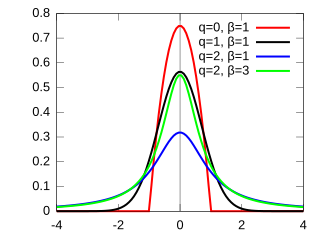In mathematics, a transcendental function is an analytic function that does not satisfy a polynomial equation, in contrast to an algebraic function. In other words, a transcendental function "transcends" algebra in that it cannot be expressed in terms of a finite sequence of the algebraic operations of addition, subtraction, multiplication, division, raising to a power, and root extraction.
In mathematics, a closed-form expression is a mathematical expression that uses a finite number of standard operations. It may contain constants, variables, certain well-known operations, and functions, but usually no limit, differentiation, or integration. The set of operations and functions may vary with author and context.
In mathematics, a q-analog of a theorem, identity or expression is a generalization involving a new parameter q that returns the original theorem, identity or expression in the limit as q → 1. Typically, mathematicians are interested in q-analogs that arise naturally, rather than in arbitrarily contriving q-analogs of known results. The earliest q-analog studied in detail is the basic hypergeometric series, which was introduced in the 19th century.
The term Tsallis statistics usually refers to the collection of mathematical functions and associated probability distributions that were originated by Constantino Tsallis. Using that collection, it is possible to derive Tsallis distributions from the optimization of the Tsallis entropic form. A continuous real parameter q can be used to adjust the distributions, so that distributions which have properties intermediate to that of Gaussian and Lévy distributions can be created. The parameter q represents the degree of non-extensivity of the distribution. Tsallis statistics are useful for characterising complex, anomalous diffusion.
In mathematics, in the area of combinatorics and quantum calculus, the q-derivative, or Jackson derivative, is a q-analog of the ordinary derivative, introduced by Frank Hilton Jackson. It is the inverse of Jackson's q-integration. For other forms of q-derivative, see Chung et al. (1994).
In algebraic geometry, a period is a number that can be expressed as an integral of an algebraic function over an algebraic domain. Sums and products of periods remain periods, so the periods form a ring.
A hypertranscendental function or transcendentally transcendental function is a transcendental analytic function which is not the solution of an algebraic differential equation with coefficients in Z and with algebraic initial conditions.
In mathematics, the Hahn polynomials are a family of orthogonal polynomials in the Askey scheme of hypergeometric orthogonal polynomials, introduced by Pafnuty Chebyshev in 1875 and rediscovered by Wolfgang Hahn. The Hahn class is a name for special cases of Hahn polynomials, including Hahn polynomials, Meixner polynomials, Krawtchouk polynomials, and Charlier polynomials. Sometimes the Hahn class is taken to include limiting cases of these polynomials, in which case it also includes the classical orthogonal polynomials.
In statistics, a Tsallis distribution is a probability distribution derived from the maximization of the Tsallis entropy under appropriate constraints. There are several different families of Tsallis distributions, yet different sources may reference an individual family as "the Tsallis distribution". The q-Gaussian is a generalization of the Gaussian in the same way that Tsallis entropy is a generalization of standard Boltzmann–Gibbs entropy or Shannon entropy. Similarly, if the domain of the variable is constrained to be positive in the maximum entropy procedure, the q-exponential distribution is derived.

The q-Gaussian is a probability distribution arising from the maximization of the Tsallis entropy under appropriate constraints. It is one example of a Tsallis distribution. The q-Gaussian is a generalization of the Gaussian in the same way that Tsallis entropy is a generalization of standard Boltzmann–Gibbs entropy or Shannon entropy. The normal distribution is recovered as q → 1.

The q-exponential distribution is a probability distribution arising from the maximization of the Tsallis entropy under appropriate constraints, including constraining the domain to be positive. It is one example of a Tsallis distribution. The q-exponential is a generalization of the exponential distribution in the same way that Tsallis entropy is a generalization of standard Boltzmann–Gibbs entropy or Shannon entropy. The exponential distribution is recovered as
In mathematics, the Askey scheme is a way of organizing orthogonal polynomials of hypergeometric or basic hypergeometric type into a hierarchy. For the classical orthogonal polynomials discussed in Andrews & Askey (1985), the Askey scheme was first drawn by Labelle (1985) and by Askey and Wilson (1985), and has since been extended by Koekoek & Swarttouw (1998) and Koekoek, Lesky & Swarttouw (2010) to cover basic orthogonal polynomials.
In mathematics, the Hahn–Exton q-Bessel function or the third Jackson q-Bessel function is a q-analog of the Bessel function, and satisfies the Hahn-Exton q-difference equation. This function was introduced by Hahn (1953) in a special case and by Exton (1983) in general.
Wolfgang Hahn was a German mathematician who worked on special functions, in particular orthogonal polynomials.
In mathematics, an orthogonal polynomial sequence is a family of polynomials such that any two different polynomials in the sequence are orthogonal to each other under some inner product.

In statistics, the q-Weibull distribution is a probability distribution that generalizes the Weibull distribution and the Lomax distribution. It is one example of a Tsallis distribution.